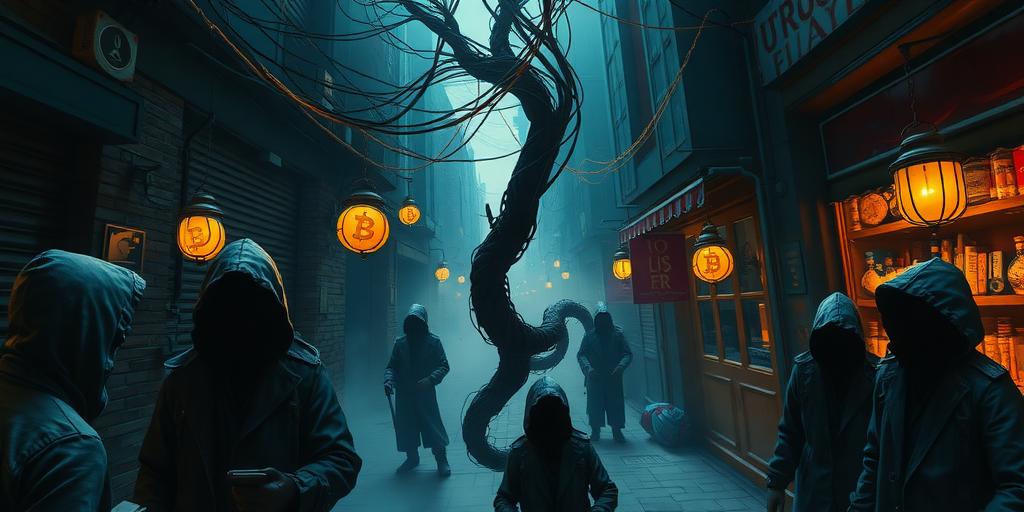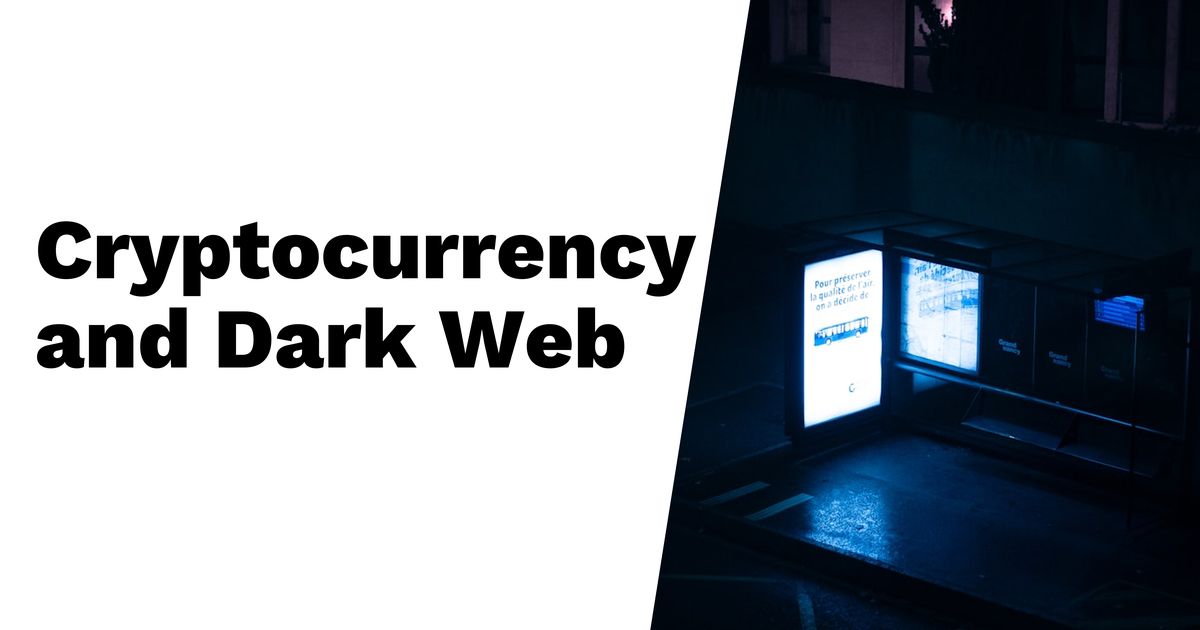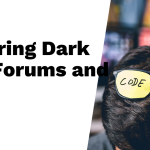In 2025, dark web marketplaces (DNMs) continue to thrive as cryptocurrency evolves, making them more elusive. Despite heightened law enforcement efforts, these markets received around $2 billion in Bitcoin and significant revenue from fraud shops. Key contenders like Abacus Market and Brian’s Club adapt by shifting from Bitcoin to privacy coins such as Monero for better anonymity. The landscape shows a shift toward decentralized finance platforms, highlighting vendors’ creativity in avoiding detection. Wholesale drug transactions dominate this space, while emerging players like TorZon fill voids left by major takedowns. Enhanced security measures aim to build user trust amid constant change in this shadowy economy.
Table of Contents
- Market Overview of Dark Web Marketplaces in 2025
- Trends in Cryptocurrency Usage for DNMs
- Dynamics of Dark Web Market Transactions
- Impact of Law Enforcement on Dark Web Marketplaces
- Adaptations of DNMs to Evolving Threats
- Security Features Enhancing User Trust
- Emergence of New Dark Web Market Players
- Future Directions of Dark Web Marketplaces in 2025
- Frequently Asked Questions
Market Overview of Dark Web Marketplaces in 2025

Dark web marketplaces are still flourishing, even with the increasing efforts from law enforcement. In 2024, these marketplaces reported revenues around $2 billion, demonstrating a robust demand for illicit goods. Key players like Abacus Market and Brian’s Club have carved out their niches, focusing primarily on drugs and stolen credit card data respectively. The shift towards privacy-focused cryptocurrencies, particularly Monero, indicates a strong desire among users for anonymity in their transactions, as law enforcement agencies have become more adept at tracing Bitcoin transactions.
Additionally, DNMs are diversifying their offerings to reach niche markets, which allows them to stay resilient against law enforcement crackdowns. This competition has led to unique product offerings and dynamic pricing strategies. The demand for illicit goods remains high, as evidenced by user growth in DNMs, prompting further attention from law enforcement. The rise of decentralized platforms is also noteworthy, as they represent a significant change in transaction methods on the dark web.
Emerging markets are continually adapting to new technologies, enhancing their security frameworks to protect users. Enhanced security measures, like two-factor authentication and PGP encryption, are becoming standard to build trust within the community. As the landscape evolves, DNMs are likely to keep innovating, responding to external pressures and seizing new market opportunities.
| Market | Revenue (2024) | Key Offering | Cryptocurrency Focus |
|---|---|---|---|
| Abacus Market | $950 million | Drugs | Monero (XMR) |
| Brian’s Club | $300 million | Stolen Credit Cards | Bitcoin (BTC) |
| STYX Market | $500 million | Multiple Illicit Goods | Monero (XMR) |
| Russian Market | $350 million | Drugs and Hacking Tools | Bitcoin (BTC) |
| TorZon | $150 million | Various Illicit Goods | Privacy Coins |
Trends in Cryptocurrency Usage for DNMs
The dark web marketplace landscape is shifting significantly as cryptocurrency use evolves. One prominent trend is the move away from Bitcoin towards Monero, a change driven by the increasing demand for privacy in transactions. Monero’s ability to mask transaction details makes it a preferred choice for those seeking to avoid law enforcement scrutiny. Additionally, decentralized finance (DeFi) platforms are becoming popular among DNMs, allowing vendors to manage their funds more discreetly, thus reducing their exposure to detection.
Stablecoins are also gaining traction within DNMs due to their lower volatility, which facilitates smoother transactions. This stability is crucial for vendors who need to manage price fluctuations in an unpredictable market. Moreover, combining multiple cryptocurrencies within a single transaction has emerged as a strategy to obfuscate payment trails, making it harder for authorities to trace illicit activities.
New cryptocurrencies and tokens are continuously being explored as alternatives, showcasing the ongoing innovation in the crypto space. Some DNMs are even adopting hybrid models that incorporate both traditional and crypto payment methods, broadening their appeal to a wider user base. The rise of crypto mixers further illustrates a tactical approach to enhance transaction anonymity, allowing users to obscure their digital footprints effectively.
To encourage the adoption of specific cryptocurrencies, some DNMs are offering incentives, creating a competitive environment that drives users to try new options. Blockchain explorers are also becoming more sophisticated, enabling vendors to track market trends and adjust their strategies accordingly. As a result, education around cryptocurrency usage is increasing among vendors, helping them navigate the complexities of digital currencies more adeptly.
- The shift from Bitcoin to Monero reflects a growing need for privacy in illicit transactions.
- DNMs are increasingly using decentralized finance platforms to manage their funds more discreetly.
- Stablecoins are being adopted for their lower volatility, aiding in smoother transactions.
- There is a noticeable trend of combining multiple cryptocurrencies within a single transaction to obfuscate trails.
- Emerging tokens are being explored as alternatives, showcasing innovation in the crypto space.
- Hybrid models are developing, where DNMs utilize both traditional and crypto payment methods.
- The rise of crypto mixers indicates a strategy to enhance transaction anonymity further.
- Some DNMs are offering incentives for using specific cryptocurrencies to encourage adoption.
- The use of blockchain explorers is becoming more sophisticated within DNMs to track market trends.
- Vendor education on cryptocurrency usage is increasing, helping them navigate the complexities of digital currencies.
Dynamics of Dark Web Market Transactions
Dark web marketplaces are primarily driven by the wholesale drug trade, making up a substantial portion of transaction volume. This dominance showcases the extensive networks of organized crime that facilitate these large-scale purchases. As these markets evolve, transaction volumes can swing widely, influenced by varying supply and demand factors. For instance, certain drugs may see price drops due to an influx of suppliers, while unique items like hacking tools are becoming more valuable as demand outpaces supply.
To enhance trust in this otherwise murky environment, many marketplaces are implementing user feedback systems. These systems help establish a reputation among buyers and sellers, fostering a sense of reliability. Additionally, the rise of escrow services is noteworthy; they act as intermediaries to ensure that both parties fulfill their obligations, reducing the risk involved in transactions. Interestingly, the average size of these transactions varies greatly, with some reaching significant amounts for high-stakes deals, reflecting the diverse needs within the dark web economy.
Anonymity remains a critical concern, shaping how these marketplaces operate. As law enforcement continues to crack down on illicit activities, DNMs are increasingly moving towards privacy-focused cryptocurrencies like Monero, which offer better protection against traceability. Seasonal trends also play a role in the market dynamics; for example, certain goods may spike in demand during specific times, indicating a cyclical nature to what is being traded. Overall, the landscape of dark web transactions is in constant flux, driven by competition, security needs, and the ever-changing demands of its users.
Impact of Law Enforcement on Dark Web Marketplaces
International cooperation among law enforcement agencies has become a powerful tool in disrupting dark web marketplaces. Major takedowns, such as those of BidenCash and Hydra, have led to significant revenue declines for affected DNMs, exposing their vulnerabilities. Legal actions against payment processors like UAPS have put additional strain on these markets, forcing them to explore alternative payment strategies. As authorities increase monitoring, DNMs are compelled to enhance their security measures to protect their operations. This heightened law enforcement presence has temporarily decreased user activity on some platforms, as fear of crackdowns looms over the community.
Ongoing investigations into DNMs indicate that authorities are committed to dismantling these criminal operations. The ability of law enforcement to trace cryptocurrency transactions is driving many DNMs to adopt more privacy-focused solutions, such as Monero, which offers better anonymity than Bitcoin. Success stories from law enforcement can create a chilling effect, leading to reduced user engagement in specific markets. In response to this pressure, DNMs are adapting their operational strategies and diversifying their product offerings, ensuring they remain operational amidst the ongoing threat of legal repercussions.
Adaptations of DNMs to Evolving Threats
Dark web marketplaces (DNMs) are continuously evolving to address the growing threats they face, particularly from law enforcement and cybersecurity challenges. To stay operational, many DNMs are increasingly outsourcing their hosting and payment processing to third-party services. This strategy allows them to reduce direct risks while maintaining anonymity. For instance, some markets now use specialized infrastructure providers to keep their operations under the radar.
Moreover, DNMs are diversifying their offerings by creating niche markets that cater to specific criminal needs, such as data breaches or counterfeit goods. This segmentation not only helps them survive but also ensures that they meet the varied demands of their users. Advanced encryption technologies are being adopted more widely, with marketplaces implementing stronger security measures like two-factor authentication and PGP encryption to protect user data and transactions. Regular updates and patches are now standard practice to address any vulnerabilities that could be exploited by adversaries.
Collaboration among DNMs is also on the rise, with some sharing security practices to enhance overall safety. This cooperative approach reflects a growing understanding that a united front can better withstand external pressures. Additionally, user education is emphasized to help individuals recognize potential scams and hacks, further fortifying the marketplace ecosystem.
To build user trust and deter law enforcement scrutiny, DNMs are investing heavily in cybersecurity measures. They are also introducing diverse payment options to accommodate users’ preferences, which enhances anonymity. Some marketplaces are even exploring the integration of AI and machine learning to predict market trends and user behavior, ensuring they remain one step ahead in this ever-changing environment.
Security Features Enhancing User Trust
In the evolving landscape of dark web marketplaces, security features play a crucial role in fostering user trust. Two-factor authentication (2FA) has become a common practice, adding an extra layer of protection for users accessing these anonymous platforms. Additionally, PGP encryption ensures that communications and data exchanged between users remain confidential, shielding them from unwanted surveillance. Marketplaces like STYX have implemented rigorous vetting processes for new vendors, which helps in maintaining a trustworthy environment.
User reputation systems are also growing more sophisticated, allowing buyers to effectively gauge the credibility of sellers based on past transactions and feedback. Some marketplaces are introducing insurance options for transactions, providing users with a safety net against potential losses. Furthermore, transparency reports detailing security incidents are shared with the community, helping to build confidence among users. Regular security audits are conducted to identify and fix vulnerabilities, which is vital for maintaining the integrity of these platforms.
An increased focus on user education about security practices helps mitigate risks associated with dark web transactions, empowering users to protect themselves. The rise of decentralized hosting solutions also reduces the likelihood of takedowns by authorities, making it harder for law enforcement to disrupt operations. Collaborative efforts to share threat intelligence among DNMs enhance overall security, creating a more resilient network of marketplaces.
Emergence of New Dark Web Market Players
New dark web marketplaces, such as TorZon, are stepping in to fill the void left by larger players that have exited. These newcomers are quickly attracting users who are looking for alternatives, often implementing innovative security measures from the outset. This focus on safety appeals to tech-savvy individuals who prioritize anonymity. Specialized markets are also beginning to emerge, each catering to specific types of illicit goods like drugs or stolen data, which allows them to meet demand more precisely. The agility of these new platforms enables them to respond swiftly to changing user preferences and law enforcement actions, a necessary trait in such a dynamic environment.
Marketing strategies have evolved as well, with many new DNMs using social media and online forums to engage with potential users directly. This approach not only helps build a user base but also fosters a sense of community among buyers. Competitive pricing strategies are common as these markets aim to establish themselves in an increasingly crowded space. Partnerships with established vendors are being formed to gain credibility and trust, which are crucial for success in the dark web.
Moreover, the rise of decentralized markets is introducing alternative platforms that can resist traditional law enforcement takedown efforts. User experience has become a priority for these new DNMs, incorporating features that enhance usability and engagement, ensuring that they meet the needs of their users effectively. The emergence of these new players reflects the ongoing demand for illicit goods and underscores the resilience of the dark web economy.
Future Directions of Dark Web Marketplaces in 2025
The dark web marketplace landscape is expected to shift significantly by 2025, largely influenced by the ongoing battle between technological advancement and law enforcement efforts. As various authorities continue to crack down on illicit activities, DNMs (dark net marketplaces) will likely need to innovate to stay ahead. Privacy coins, such as Monero, are anticipated to become even more popular among users who prioritize anonymity in their transactions. This demand for privacy will drive many DNMs to adopt these currencies for their enhanced security features.
With the economic climate in constant flux, DNMs may also see a clearer segmentation within their markets. For instance, we could witness distinct categories emerge, such as specialized platforms for drug trade versus those catering to data breaches. This division could help vendors target specific audiences more effectively and streamline their offerings to meet the unique needs of various user groups.
As user habits evolve, DNMs will adapt their services accordingly. The feedback from communities engaged in these marketplaces will play a crucial role in shaping their future. Emerging technologies, including enhanced blockchain applications, could redefine transaction processes, making them faster and more secure, while also complicating law enforcement’s ability to track illicit activities.
Furthermore, the rise of decentralized platforms may compel traditional DNMs to rethink their operational models, pushing them toward more resilient and innovative strategies. This dynamic interplay between technology and law enforcement will continue to dictate the evolution of dark web marketplaces, underscoring the need for constant vigilance and adaptation in this ever-changing environment.
Frequently Asked Questions
How does cryptocurrency help in dark web transactions?
Cryptocurrency allows users to make transactions anonymously, which is crucial for buying and selling on the dark web. This anonymity makes it harder for authorities to track and identify users.
What types of cryptocurrency are popular on dark web marketplaces?
Bitcoin is the most well-known cryptocurrency used on the dark web, but others like Monero and Ethereum are also popular. Monero is especially favored because it provides even more privacy.
Are dark web marketplaces safe to use if I pay with cryptocurrency?
While paying with cryptocurrency offers more anonymity, dark web marketplaces still come with risks. Scams and illegal activities are common, so it’s important to be cautious and do your research.
How is cryptocurrency changing the future of dark web marketplaces?
In 2025, we might see more advanced cryptocurrencies that offer better security and privacy features, making dark web marketplaces even tougher to regulate and monitor by authorities.
Can law enforcement track cryptocurrency used on the dark web?
Yes, law enforcement can sometimes track cryptocurrency transactions using blockchain analysis. However, they often struggle with cryptocurrencies that focus on privacy.
TL;DR In 2025, dark web marketplaces (DNMs) are adapting to increased law enforcement pressure, shifting from Bitcoin to privacy-focused cryptocurrencies like Monero. Despite a decline in revenue due to international crackdowns, DNMs remain profitable, with 71-81% of transactions linked to wholesale drug purchases. Emerging players like TorZon are filling market gaps, while enhanced security measures like two-factor authentication are fostering user trust. The landscape will continue evolving, highlighting the need for rigorous monitoring in cybersecurity and law enforcement.





